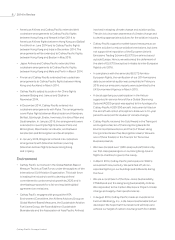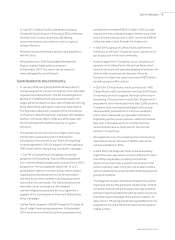Cathay Pacific 2014 Annual Report Download - page 19
Download and view the complete annual report
Please find page 19 of the 2014 Cathay Pacific annual report below. You can navigate through the pages in the report by either clicking on the pages listed below, or by using the keyword search tool below to find specific information within the annual report.
ANNUAL REPORT 2014
17Review of Operations Passenger Services
Home market – Hong Kong and Pearl River
Delta
• Demand for leisure travel from Hong Kong was strong for
most of 2014, especially during the Chinese New Year,
summer and Christmas peak periods.
• Korea was the most popular leisure destination for
Hong Kong travellers in 2014. The depreciation of the
Japanese yen increased demand for travel to Japan,
but increased capacity put yield under pressure.
• There was strong demand for travel to our three
destinations in Taiwan, especially during the summer.
• Demand for premium economy class seats increased
in 2014.
• Demand for leisure and business travel from the Pearl
River Delta continued to increase in 2014. We increased
our sales force in Guangzhou.
• Demand for corporate travel increased in 2014. However,
it was not as strong as expected in the normally
seasonally strong second half of the year.
India, Middle East, Pakistan and Sri Lanka
• Passenger traffic on our South Asia routes was generally
robust in 2014. The Delhi non-stop service was
increased from daily to twice-daily in March 2014. Four of
the seven flights a week to Colombo became non-stop in
October 2014.
• We stopped flying to Karachi in June 2014.
• In March 2014, Cathay Pacific introduced a daily service
to Doha. We introduced codeshare services with Qatar
Airways at the same time. Load factors on the Doha
route increased during the year.
• We reorganised our network in the Middle East in 2014.
We stopped flights to Abu Dhabi and Jeddah but
improved our schedules on other Middle Eastern routes.
Competition has intensified and market conditions are
difficult in the Middle East. More airlines are flying direct
between the Middle East and Southeast Asia.
Southwest Pacific and South Africa
• The performance of our Australian routes was
satisfactory in 2014. Traffic between Mainland China and
Australia was stable, despite competition from airlines
flying non-stop.
• Our business on the Sydney route was helped by the
cancellation of a competitor’s services between Hong
Kong and Sydney in May 2014. We began using Boeing
777-300ER aircraft on one of our Sydney flights in
December 2014, so adding capacity on the route. In
October 2015, we will add another Boeing 777-300ER
aircraft to the route.
• We reorganised certain services to Australia. We now
operate four-times-weekly direct flights to Adelaide,
three-times-daily direct flights to Melbourne and a daily
direct flight to Brisbane. There is also a tagged flight
between Brisbane and Cairns, four times a week.
• The New Zealand route was robust in 2014, helped by the
joint venture with Air New Zealand. We increased the
frequency of the Auckland service to twice-daily in the
northern winter.
• The South African route was weak in 2014. It was
adversely affected by the weakness of the South African
currency and, in the second half, by a decline in group
travel to Africa as a result of negative publicity about the
Ebola outbreak in West Africa.
Southeast Asia
• Demand for travel to Malaysia, Thailand and Vietnam was
adversely affected by political unrest in the first half of
2014. We reduced capacity on the Bangkok route but
gradually restored it towards the end of the year.
• Strong competition affected the performance of our
Philippines routes.
• The Singapore route performed well despite
intense competition.
• Business to and from Indonesia was affected by the
presidential election in the third quarter of 2014.
• Cathay Pacific stopped and Dragonair started flying to
Penang in March 2014. The schedule and frequency (10
flights per week) remain the same. Dragonair introduced
a twice-weekly service to Denpasar-Bali in April 2014.
• Dragonair increased the frequency of its flights to
Phuket, Siem Reap and Yangon.
























